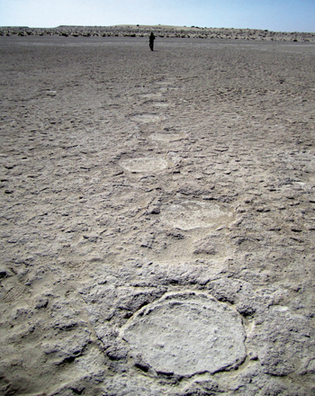 loading
loading
FindingsOn the right trackGaining insight from ancient footprints.  Faysal BibiA close-up of tracks at the Abu Dhabi trackway site. View full image
Around seven million years ago, in what is today the western part of Abu Dhabi, a group of about a dozen elephant-like animals of various sizes ambled across a stretch of very shallow water. The creatures weighed enough that their feet broke through the crust made by microbes and left tracks. Those footprints crossed another path stamped in the microbial mat by a lone, large proboscidian, as these trunk-bearing mammals are known, that was traveling through the area at about the same time. Today, the area is desert, and the tracks left behind demonstrate that a fundamental pattern of modern elephant social behavior has been in place for a very long time. Yale paleoanthropologist Andrew Hill, paleontologist Faysal Bibi ’09PhD, and their colleagues examined the tracks and published their results in a paper in the February 22 online edition of Biology Letters. Today’s elephant species are characterized by female-dominated families, typically made up of 5 to 16 individuals. At sexual maturity, the males, which are larger than the females, leave the group to wander on their own. The Hill team’s analysis of the footprints showed that both herding and solo-traveling behaviors were present among the animals from which modern elephants evolved. “It’s so rare to get insight into the family life of fossils,” says Hill. “But here it is.” However, when the research team began studying the Abu Dhabi trackway, in 2006, it was so large—around 270 meters long—“we couldn’t figure out what was going on,” says Hill. So they used cameras suspended from kites to take aerial images, and then they applied a tool called GigaPan, which enables researchers to create and examine panoramic photos. “As soon as we saw the first GigaPan, we could tell that it really was a herd traveling together, and that there was a separate track of a solitary, very large individual intersecting with it. There’s incredible detail,” says Hill. “The trackway is a snapshot in time and the first direct evidence that the complex social structure we find in today’s elephants has ancient roots.”
The comment period has expired.
|
|